Rishad Tobaccowala's Blog, page 25
May 23, 2021
Eight Client and Customer Expectations.

Illustration by Irena Zablotska
Over the course of four decades of working with clients and customers all over the world, their needs regardless of industry, size, or the country they operate in, almost always distill down to eight key expectations from their service providers.
Four of these expectations are focused on outputs and outcomes and four of them focus on process or how the partner works.
Outputs: Insights, Ideas, Inspiration, and Implementation.
Process: Collaboration, Continuous Improvement, Operating Discipline, and Values.

Illustration by Irena Zablotska
4 Key Output Expectations
1. Insights: Clients pay the highest premium in not just economic value but their attention and their admiration to firms that bring them insights about their customers or their business. Client relationships can be salvaged, or business can be poached away by firms that can provide a new way of understanding the marketplace. Something that is so obvious and yet not obvious. If we are living in an age where people are in control and markets are being transformed, there is a premium placed on perspectives that allow a firm to better understand their customers and analyze their markets in ways that provide an edge against the competition.
2. Inspiration: External suppliers and partners see a world different than a client. Most work across different industries and have a different employee mix. Clients in these changing times want to know how they benchmark against the best. Not just their industry, but across industries. Showing them examples, exposing them to different stimuli, bringing in outside experts, all speak to this hunger, while underlining that their partners are in touch with changes happening around them.
3. Ideas: In the end despite debate as to whether they pay adequately for ideas, every client cares a lot about ideas and without a good flow of them it is hard for an outside partner to remain valuable. Even if a client does not buy the ideas, the inability to present ideas, including ones that stretch and are out there, often is reason for the clients eye to wander. Best partners provide “gifts” of a big idea or two every few months.
4. Implementation: Eventually insights, inspiration and ideas mean little if they cannot be implemented in the marketplace. Clients look for firms that have the skills either internally or thought tight partnerships to yield tangible programs, products or services into the marketplace in a cost-effective timely manner. Skills that are relevant to changing times and beat to the metronome of increasing rapidity are critical.

Illustration by Irena Zablotska
4 Key Process Expectations:
While insight, inspiration, ideas, and implementation are the wings of a healthy partnership, there are some processes or ways of working that are as important and often can carry a relationship when the ideas, insights, ideas, or implementation are wanting or can challenge a partnership when not present even if ideas, inspiration, and insights are flowing
1. Collaboration: Clients hate (and it is not too strong a word) the lack of collaboration between their various partners. They resent having to baby sit grownups who cannot play together. They see the friction as a loss of time and economic value. As industries blur in the digital world and many partners all claim expertise or rights to the same area (e.g., “social”) this has become an obsession with clients. The words “childish”, “soap-operatic” and” I wish I could dump the whole lot and start again” are heard. Yes, often the client’s incentives and structures encourage the petty and insecure behavior we engage in when our turf emotions and short-term economic incentives make us forget the big picture. The big picture is that clients are trying to build economic value of their brands via insights, ideas, inspiration, and cost-effective implementation and frankly will reward for that.
2. Continuous Improvement: In a world of change, businesses ask if the outside partner is continuously improving themselves. Are they remaining curious, challenging the status quo, and leveraging technology or other efficiencies costs, becoming more productive? Businesses are under intense pressure to enhance productivity and are looking for their partners to become more productive themselves. This is not just about cutting costs but also developing better product, re-using ideas from one part of the globe in another, eliminating or automating things that can be.
3. Operating Discipline: This is the least sexy and interesting part of what clients want because in many ways they expect it. Can their partner run their own business by managing budgets, schedules, legal clearances, and the like? Are they responsiveness and do they staff with capable people? Can the agency or partner make the trains run on time, read the signals, and ensure the engine stays on track? The wrong ad shipped to the wrong media company, lack of legal approval and non-responsiveness in an emergency get folks fired all the time.
4. Values: This is an expectation that has grown increasingly important over recent years as companies increasingly care about employee well-being, diversity, and purpose. Integrity and trust have always been critical to Clients, but they now want to know about the workforce of their suppliers and partners. Are they being treated well? Are the sufficiently diverse? Is the company giving back to society?

Illustration by Irena Zablotska
A way to build enduring Client and Partner relationships
One way to keep enduring relationships is schedule a meeting every six months with key partners and clients and provide a quick review of four areas.
What ideas, insights or outside inspiration were provided in the past six months?
What were the key challenges and successes in program implementation?
Where did collaboration thrive between partners with Clients and where can they improve?
Which products or services or employee programs were developed or enhanced over the past six months by your firm?
These meetings provide multi-faceted benefits:
They focus teams on making sure they are working the 8 key areas that clients evaluate their suppliers since there will be a meeting to share progress.
It allows clients and their partners to celebrate and often merchandise the progress they have made; share the issues they have uncovered and plan how to build on things that work and correct those that do not without all the emotion and drama of being fired or reviewed or put on notice.
It enables both sides to understand how expectations are changing and which areas are critical and need to be focused on.
Success in an increasingly connected world is the power of connections and relationships between people and partners. Constant updating of expectations, continuous communication and celebrations of successes build understanding and fuel enduring relationships.
May 16, 2021
Constrained Growth 2.0
Some 14 months ago, a few days into the US lockdown, on March 30, 2020, in a piece titled “Constrained Growth” I tried to imagine how the lockdown might change us:
[image error]
Today’s constraints on our physical movements can provide the opportunity to enlarge our mental and emotional capabilities to such an extent that it may lead to a great re-invention.
Emotionally the crucible of change we are in can make us feel differently about our lives, our connections, and our work.
Mentally the stress in the foundry of uncertainty will twist our thinking in one or more ways as we seek to make sense of what has happened and plans for when the constraints lift.
In many ways it will make us appreciate what we took for granted.
In others as we forgo certain behaviors and have the time to ponder and ruminate on our previous days, we may question why we did certain things.
We will question many aspects of our lives and we will make resolutions.
Every one of us will adapt, evolve, and meld different versions of ourselves and interact with a world of people and institutions that are different.
We may have gone into this crisis as MS-DOS and focused on the narrow corridors of ourselves but if we spend the next few weeks correctly, we could come out as Windows 10 with expanded horizons…
Over a year later.
The pandemic is still with us, and it is causing great devastation in India. Many areas of Japan are back in an emergency lockdown with the Olympics only a few weeks away. However, in the US with significant portions of the population vaccinated and an easing of the need to wear a mask, life will likely return to familiar routines.
As the constraints ease and the limits are removed will we return to the way we were?
Every individual will be emerging from the past year in different ways. Over half a million people in the United States who were lost to Covid will not be here to register these days. The tens of millions who were connected to them will always see a gap, a shadow and an empty chair which was previously occupied. Others among us may have lost jobs or needed to move back home or move away to a different place. Relationships have been strengthened and sundered. Rituals were postponed, delayed, or virtually held. All these have made their mark and left their invisible tattoos.
[image error]Limits can lead to growth.
Many have found growth amidst the constraints and limits.
In the ordinary.
In less.
In enough.
In endings.
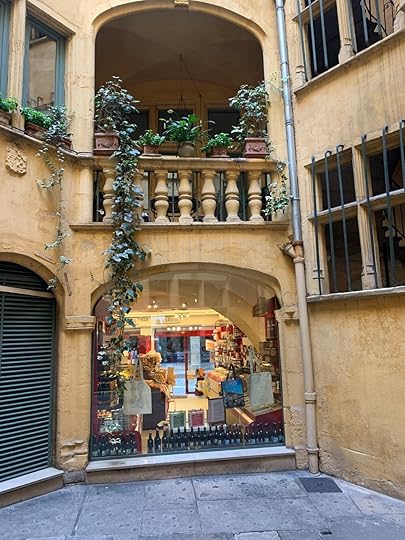
Ordinary.
There is a newly found appreciation for the ritual of the ordinary day.
We might have pined for the extra-ordinary, the special and the memorable eighteen months ago.
But as we sat socially distanced, masked, and locked down the little habits, movements and freedoms of every day loomed large.
Sometimes one does not know what one has until one loses it.
Happiness is not often in the one day in the future or getting promoted to the right level at work or when the right “number” is reached.
It is in the ordinary of good health, relationships, and freedom.
The extra-ordinariness of “everyday ordinary” is what is special to many.
[image error]Less.
All we may need is less.
For many people the tragedy of Covid-19 has been a lack of food, shelter, jobs, money, and health care. For many others especially people with white collar jobs that can be done remotely we are realizing that except for space we could do with less.
How many of the things you have, or the past harried routines or frenetic travel are you missing?
All the frenzy of movement and much more remind us of William Wordsworth’s lines.…the world is too much with us; late and soon. Getting and spending, we lay waste our powers...
Many people are using this time to re-consider their lives and many are discovering that all they need is less.
And if one needs less, it opens a world of options since we may be able to pursue the dream our previous lifestyle may have priced us out of.
[image error]Enough.
Jack Brennan the CEO of Vanguard has a new book out called “Straight Talking on Investing” in which he quotes the journalist Jason Zweig from a January 2000 Money magazine column:
“I once interviewed dozens of residents in Boca Raton, one of Florida's richest retirement communities. Amid the elegant stucco homes, the manicured lawns, the swaying palm trees, the sun and the sea breezes, I asked these folks - mostly in their 70's - if they'd beaten the market over the course of their investing lifetimes. Some said yes, some said no. Then one man said, "Who cares? All I know is, my investments earned enough for me to end up in Boca."
The moral of this story is three-fold.
a) What are our goals in life?
b) There is a need for finish lines. Comparison is the thief of joy. Continuous benchmarking is a recipe for always coming up short. Living in the minds of other people might leave us empty. Are we happy with what we have when we have them or only when we can show others that we have them?
c) Enough. The most satisfied people recognize the power of enough. Living in a fervor of continuous measurement means you live by the scoreboard, and we stop focusing on the ball.
Life is the ball and not the scorecard.
[image error]Endings
Franz Kafka wrote “The meaning of life is that it stops.”
In the future the ritual of the ordinary day will be special, just as we have come to realize after months of a new way of living that the simple pleasures of free movement, meeting friends, sitting in a crowded bar, and watching a sports game were so special.
Life does not have to be lived forward and understood backward if we decide to pay attention.
We can use the lessons of 2020 to be aware of the fading moments of now.
Look around you. Watch the special quality of light or listen to the hiss of the air duct. Treasure the conversations and even the repetition and lack of differentiation of day after day.
Because one day it will not be so…
So, as we get back to the way it was maybe the year of constrained living with anxiety, fear and uncertainty has grown all of us in ways that show that limits can free us and concentrate the mind and heart on what matters.
All Photographs by Rishad Tobaccowala
May 9, 2021
Slaying Our Inner Dinosaur

Many, if not all of us suffer from IDD.
Inner Dinosaur Disease.
The cause of this disease is change.
It is all around us. We all talk about it. We are buffeted by it. We participate in conferences about it. We hand down edicts and issue press releases about change initiatives.
But individually we abhor it. Change sucks. Particularly for decision makers.
Change exposes us to vulnerability and loss: of control, of clout, of turf and of face. It demeans the very currency of expertise, seniority, networks, and image we spend decades building. How dare some pompous young pup, some fresh idea, some innovative technology, some fearless startup, or bossy consumer challenge us?

The two-phase inner dinosaur shuffle.
We let our inner dinosaur roar and roam unleashed against these threatening changes to our ecosystem by indulging in a two-step shuffle.
First, we justify our refusal to change via the Deflection Dance!
Blame our myopic bosses who are approaching retirement or the organization that has too much money riding on status quo.
Attribute inaction to the profit pressures and business realities we carry on our shoulders.
Suggest the Client or Customer gave only lip service to change readiness.
Rebuke the employees. They are not trained or motivated for this stuff.
Exhume specimens from the when-things-went-wrong. Remember when?
Wait for others to find the landmines.
The second step is Change Botox—little injections of temporary surface embellishments to distract from real change. Common manifestations:
Announce the retention of a Consulting firm who, over the next X months, will benchmark and develop a plan of action.
Launch a Vision or Change 202X task force to “get out in front” of change.
Hire a talent agency, next generation modern marketing firm, or niche agency, then issue a press release.
Re-launch a quiet, unsupported brand or initiative with a small budget dedicated to a new way so there is something to point to.

Five weapons slay our inner dinosaurs (and dragons!)
Here are s ways of slaying inner dinosaur disease (IDD): a) own change, b) empower the iconoclasts, c) cross the line, d) leverage organizational inertia, e) act to change or change your act

1. Own change. If you change, others will follow. If they do not, change your partners, or your options.
It cannot be achieved via delegation, outsourcing or by committee.
Change would be easy if there were no people or organizations to get in the way. This draws a laugh, among leaders and often a pensive “so true.”
Less comfortable for the leaders who run organizations is that we are often the people who get in the way. Appointing a change agent, hiring some boutique agency with a hip name, securing a powered consultant to affect change, or just embracing cool and different behavior might be part of an answer. But it is our organization, and it is us who must eventually be the doer of new things.
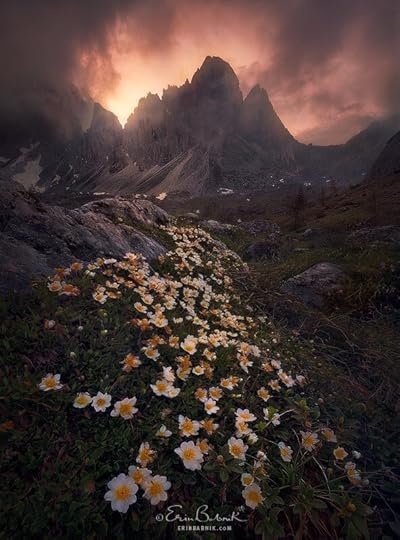
2. Empower the iconoclasts. There are many talented revolutionaries within your corporate environment, but they are often dismissed as “too junior” to add value. Seek out your best thinkers at any level or age. Listen to them, give them a platform and the support they need to achieve their goals. Encourage them to attack your ideas, your company. Too many of us get delusional surrounded by sycophants who either fear them or lust for the dollars we control.
While organizations can clearly promote a culture that is conducive to innovation, it is ultimately the individual that matters—the passionate, risk-taking, caution-to-the-wind individual. Not some group think, an organizational grope or some socialistic, homogenized, outward bound team.

3. Cross the line. We all cower within self-drawn boundaries. Too often we self-edit ourselves, fearful of crossing a line. Or we wait for permission.
Remember you do not know where the line is until you cross it.
Let ethics guide you and start changing things. Now. You will be surprised to find that people will not stop you but most likely will follow you.
Cross the line. Often you will notice the line was in your imagination. You might learn that those who once prevented you from crossing this were not aware of a line at all.
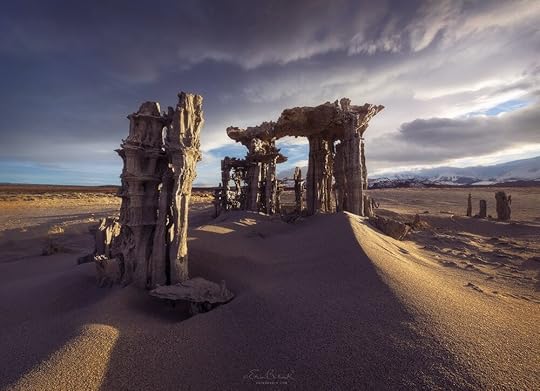
4. Leverage organizational inertia: It is possible to get “The Company” to do what we want if we simply start doing it.
If getting approval requires lots of forms, presentations, and justification, it means your organization may suffer from so much inertia it might not actually know how to say no. This is a real opportunity for the daring. Instead of asking for approval to start something, why not take the initiative and see if the company stops you? No harm done, right? Key is that idea or initiative is ethical and legal.
Most important, in today’s fast moving and ever increasingly digital world, the lines we draw around our categories are disappearing. So are the barriers and lines that once controlled competition in our industries. Did any phone company executive a few years ago predict competition from Skype? Or Whats App? New competitors appear all the time, as do new threats, but so do new potential partners and opportunities.
Crossing the line is a lonely job. It is you who must eventually be the doer of new things.
If you are successful, why not be willing to take a risk? Are you not amazed at how many admired, world class organizations are overly cautious? If they cannot grasp the opportunity to fail at some greater thing, are they not already in the process of ossification?

5. Act to change or change your act.
You might be a highly talented individual cowering within some imagined or real constraint. If your company is repressing you and you are good, risk taking can only beget one of two outcomes. You will succeed or you will be asked to leave. If you are asked to leave and you are good, many companies will be ready to hire you, or you could go into business for yourself. But staying put and becoming some bureaucratic czar will eventually lead to you resenting yourself and reducing your market value.
Do yourself a favor. Cross the line. Most times no one will stop you.
Challenge yourself to fail once you have succeeded.
Seize bigger opportunities!
All non-dinosaur photography by Erin Babnik
May 2, 2021
Repair
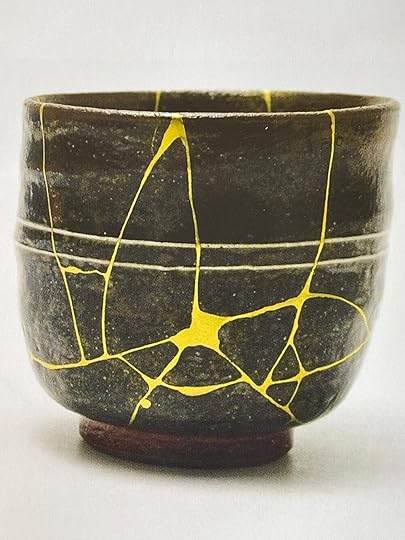
“Everything that has a shape breaks”- Japanese Proverb
But…
“The world breaks everyone and afterward many are strong at the broken places”- Ernest Hemingway
And…
“Repair is the creative destruction of brokenness”—Elizabeth Spelman
Five paths to repair.Images and words extracted from five books that offer different perspectives that anyone can draw on since none of them have to be purchased and can be integrated into every day of almost every life.
1. Poetry 2. Water 3. Wabi-Sabi 4. Kintsugi 5. Gardens.
 1. Poetry
1. PoetryPoems restores us to what is deepest in ourselves.
Poetry finds the perfect words in the perfect order.
CK Williams in his Pulitzer Prize winning collection “Repair” writes how
‘Self-doubt is almost our definition” as we move forward with the “hesitant music” of our lives
“If I can create myself, I’ll be able to amend myself.”
“Re-establishing myself in myself like this always comes to pass”.
He celebrates “Invisible mending”.
The minds procedures of forgiveness and repair.
The greatest poetry is written at the borders of what can be said. As this stanza on persevering and resurrecting and restoring oneself through the ups and downs of life while never losing your internal melody …
“Be soft in your practice. Think of the method as a fine silvery stream, not a raging waterfall. Follow the stream. Have faith in its course. It will go its own way, meandering here, trickling there. It will find the groves, the cracks, the crevices. Just follow it. Never let it out of your sight. It will take you”. Sheng-Yang
 2. Water.
2. Water.Moving water is often symbolic of power and life. It can reputedly heal the sick and the lame, restore youth, confer fertility, dissolve sin, and so on.
It is an alchemy of thermal simulation that leaves one clean and pure and reconciles mind and body.
Flowing water whether it be rainfall, a stream, a river, or the tides of a lake or ocean has a certain timelessness to its biological rhythms.
From the Calm app to the music at a spa, our internal compass draws us to water as a place of rest, rejuvenation, and repair.
Even if it’s just the shower…
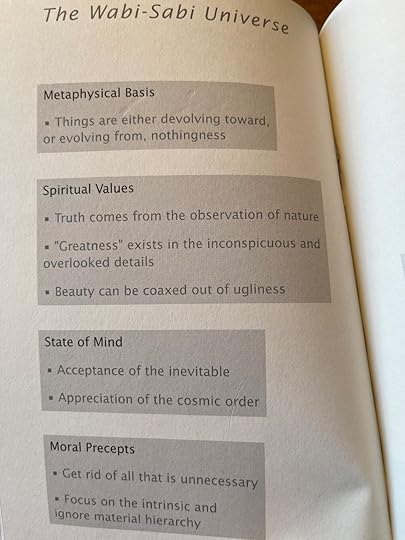 3. Wabi-Sabi
3. Wabi-SabiWabi-sabi is a beauty of things imperfect, impermanent, and incomplete. It is a beauty of things modest and humble. It is a beauty of things that is unconventional.
It is a philosophy of repair and therefore real life for it does not have perfection or ideal as a goal
Wabi refers to a way of life, a spiritual path, the inward, the subjective, a philosophical construct. It is about “space”.
Sabi refers to material objects, art, and literature, the outward the objective an aesthetic ideal, it is about “time”.
 4. Kintsugi
4. KintsugiKintsugi is a Japanese repair technique that takes ceramic destruction and makes a broken object into a new entity. It leaves clear bold visible lines with the appearance of solid gold. A kintsugi repair speaks of individuality and uniqueness, fortitude and resilience, and the beauty to be found in survival. Kintsugi leads us to a respectful acceptance of hardship and aging.
Kintsugi has in it the Wabi-Sabi philosophy and its belief of beauty, knowledge and humanity arising from the scars and the repairs is sung by Leonard Cohen…
Ring the bells that can still ring
Forget your perfect offering
There is a crack, a crack in everything
That’s how the light gets in…
And the philosopher Rumi…
“The wound is the place where the light enters you”
 5. Gardens
5. GardensIn the Charlevoix region of Quebec there lies a private garden which covers more than 20 acres and is called Les Quatre Vents ( The Four Winds). It is considered amongst the finest private gardens in the world (it is opened a few times a year to the public).
The garden was created by one person, Francis Cabot, as his life work that blends creativity and passion and it is simply the most breathtaking places one can imagine.
Francis Cabot believed that gardens are like art and have the power to change you. And unlike other art, which may affect you differently over time, because you have changed over time, a garden is itself always changing. Francis designed his garden to lift the soul of people who walked through it. To help them grow and repair and heal.
He wanted us to come out different after the experience.
Here is a peek at Les Quatre Vents…
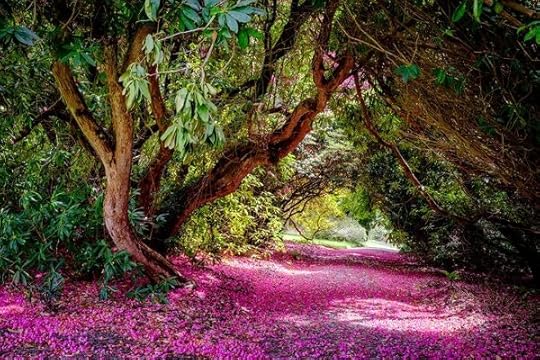
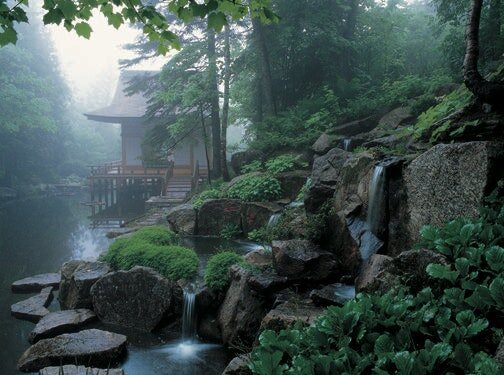
One prescription for the pressures and challenges we face is to take a walk in a garden.
Regardless, it is key to remind ourselves of Francis Cabot’s belief that every individual is creative and we have a garden within ourselves that we need to tend to so that we can heal, self-repair and always bloom…
April 25, 2021
The Future

We are all interested in the future since we will be spending the rest of our lives there.
And the future by definition is unknowable since it is yet to unfold.
However, are three very high probabilities about the future that we should heed so that we can better align and adapt to what is likely to occur.
The three high probabilities.The future will not fit the containers of the past: From organizational structure to how markets are organized, the existing ways of doing business have been optimized on what has come before. The challenge for most of us is to realize that the future refuses to be contained in the containers of the past whether it be media, money, markets or mindsets.
The future will come from the slime and not the heavens: Future prognosticating is often aligned with crystal ball gazing, scenario planning and blue-sky thinking. We look ahead and above. We watch market leaders and todays visionaries and time after time we are surprised that the future did not come from where we were looking but from those we looked down upon or were outside the “velvet rope” or who never appeared on our radar.
The future while challenging for some is likely to be much better for most: Someone said that they were not afraid of the future, but they were scared out of their minds by the headlines. When it bleeds it leads? What enrages powers the algorithms that are built on what engages. While there are real challenges and some segments of society and certain regions fail and slip back, history indicates that for humanity as a whole the future can be looked at with optimism.
 The future does not fit in the containers of the past
The future does not fit in the containers of the pastLet us consider just three arenas surround us every day: a) Media. b) Markets and Money. c) Mindsets.
MediaThere was a time that most of the media we consumed fit in containers called compact discs or DVDs or newspapers or magazines.
The have now been all unbundled down to individual scenes, songs and articles all digitized, streamed and available for re-mix and re-posting.
Media fit in containers of time whether it was a television networks programming grid, the deadlines that the newspapers and magazines went to presses and movies were marched along their windowing schedule from theater to pay tv to video to cable to tv.
Now windows have shortened and collapsed, and everything is increasingly in real time. And movies and television show long lost to time or another region are resurrected on Criterion or can be viewed with a VPN and an app. Schedules are malleable.
Media used to fit form. There was print and there was audio and there was video. But in a digitized world the containers between forms were eroded away by the hydrochloric acid of code and everything became multi-media and then immersible and swappable and interactive. This is the difference between the first pictures on Instagram and todays Instagram stories.
And even the containers of search, mobile, social and e-commerce are leaking into each other and mongrelizing as we speak. What is WeChat or a shoppable format with internal search and embed e-commerce?
Markets and MoneySoon the Miami Heat arena will be renamed for a company called FTX which allows for 24-hour trading globally of many instruments and creates new markets and instruments.
Crypto currencies and block chain which most people disdained, are re-configuring the future of transaction, store of value and exchange.
Wall Street Bets and Stock Twits are for many a modern Bloomberg terminal, and the revolution is on Robinhood.
Insurance is priced by the mile. Ownership of everything is fractionalized and tokenized. Coinbase is more valuable than Goldman Sachs and debit is the new credit as the next generation of Stripes, Squares, Affirms and Afterpays embed and engulf all.
None of these fit within the containers of the past and are so new that regulation lags and definitions fail to do them justice.
MindsetsMost of us and most managers are Baby Boomers and older and our mindsets may be the containers of the past
Millennials who are a generation or two removed from the average age of most leaders in non tech companies have grown up in a completely different environment that their management may have and one that is more aligned with where the future is going.
They grew up multi-ethnic with the US under the age of 18 turning Caucasian minority next year.
They grew up digital. Go meet them on a Discord, Twitch and Tik Tok and try to figure out what is going on.
They expect to do worse than their parents and having seen 9/11, The great recession and Covid and the rise of Uber, Task Rabbits and much more recognize that the future of work is being a gig worker thus skill building, speed, social standing are increasingly important. They operate as companies of one in real time.
They are forcing companies to become more purpose and meaning driven.
YOLO! You only live once is a real movement as are FIRE. Financially Independent Retire Early.
But it not just the mindsets of millennials that need revisiting but also how we see older people. Someone who is healthy at 50 is expected to enjoy another 30 years of good health. With people over 50 controlling over 70 percent of wealth and living 30 years and as Covid has shown capable of new behaviors we would be short sighted to give short shrift to older folks or to our own abilities to re-invent.
The past year has accelerated, accentuated and amplified all these trends. There is no going back to December 2019. If you take the entire world and shake it with a health, financial and social crisis for over a year and we do not restart or return to a new normal. Instead, we start again and prepare for the new strange.
Once a champagne cork is out of the bottle it swells and does not fit back. A mind and behavior expanded does not go back to its original shape.
 The future comes from the slime and not the heavens.
The future comes from the slime and not the heavens.IBM did not see Microsoft. Microsoft did not see Google. Nokia and Sony did not see Apple. GM, Ford and Toyota missed Tesla and Uber. And Gillette and Schick were late to recognize the power of Dollar Shave Club and Harry’s.
Coastal urban elites ensconced in bubbles of chattering chit chat and voguish self-glorification missed the measure or the temperature of the country in between. Many board rooms today continue to bathe in yesterday’s data lakes filled with dead fish and actually believe they will control and manage how people will come back to work.
The future of video did not emerge from the networks or studios, but a DVD distributor called Netflix and the dominant force in music was not based in London or LA but in Stockholm where a little company called Spotify was birthed.
In each case the threat came from a) outside the industry definition or established competitor, b) utilized a go to market strategy that in the near term made little economic sense or introduced a completely new form of distribution or pricing c) aligned with technology and demographic trends that were becoming versus technology and trends that had been.
The new entrant was therefore unknown, too little and small and or crazy.
From the dredges, the low-rent district, the outside places.
Life came from the slime according to evolution.
So will the future.
Smart management of companies today pay a lot of attention to adjacent industries and not just theirs. They understand that as we enter the third connected age of technology which will combine AI, Voice, 5G and Quantum Cloud Computing every aspect of their go to market strategy must be re-considered. They monitor and invest in start-ups and fund internal disrupters who re-imagine.
 The future will be better for most of humanity.
The future will be better for most of humanity.From Covid-19 to climate change, from inequality to increased polarization, from race relations to lunatic leaders the future looks troubled, dystopian and trauma filled.
And it might be.
Since the future is not ours to see.
But if the past is any guide, the technology and new learning being discovered and the mindset of the young generation around the world are any sign the future for most people is something to look forward to.
While there is much to be achieved let us remember that in the past 20 years 2 billion people came out of poverty, half the world’s population went online and were connected, that to have cancer was not necessarily a death sentence and being a woman or minority or gay in 2021 while still not where it needed to be was far better than two or three decades ago.
Today with quantum computing, gene and biotechnology, knowledge (not just rumor and memes) spreading fast because of the internet and new approaches to medicine and education delivery being scaled and birthed the future is much brighter than the headlines make it out to be.
Just imagine a vaccine for Covid being delivered in less than one year using technologies that were in the lab less than five years ago.
Two books, Enlightenment Now by Steven Pinker and Human Kind: A Hopeful History by Rutger Bregman make for great antidotes to the fusillade of dystopian headlines exploding across your television screen and social streams.
 Five steps to future align yourself and your firm.
Five steps to future align yourself and your firm.First it is key to understand how we and the people we serve or sell to have changed as we all come out of over a year of living differently into a world where modern technology has accelerated, amplified and augmented the way we live. What will our customers and employee and other people around us start, stop and continue to do as we proceed into years of the Third Connected Age.
Second is commit to continuous learning in a world where the half-life of knowledge and behavior is increasingly shortening. Deliberate practice and continuous improvement are key.
William Gibson wrote the future is already here but not evenly distributed. Look around the world or different markets and you will see the future and due to the acceleration of the rate of change we will constantly have to upgrade our mental operating system. Upgraded software eats the world. Static software (our minds and skills if we let them atrophy) gets written over.
Third is to imagine the exact opposite of what we believe to be true to both stretch our minds and ensure that in a world of polarized media and tight social circles we do not become mislead to feel our flatulence smells like Chanel 5.
Fourth is to remember that the future comes from the slime and from the outside. Which is from beneath us or besides us and not usually from the roped in areas we may be inhabiting. Look to the slime and not the heavens. Wonder whether you are walling yourself in rather than walling people out.
Finally, and most importantly be optimistic. Pragmatically enthusiastic not pollyannish. People follow people who have hope in their eyes and see a higher mountain to climb. Be real and align with science since fact are stubborn things and truth has a habit of breaking in. Inspire! People choose with their hearts and use numbers to justify what they do.
April 18, 2021
Meetings Re-Imagined
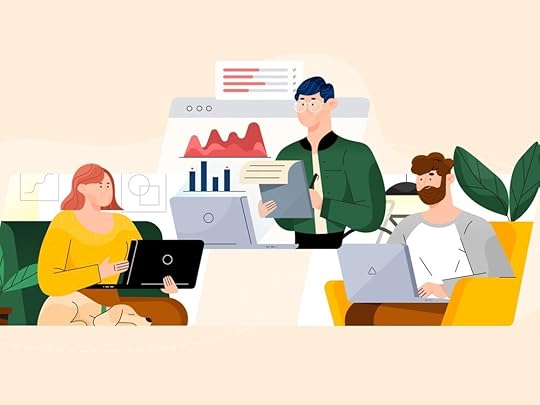
Illustration by Carolina Contreras
We spend our time in meetings.Meetings at work. Meeting friends. Meetings where you present and meetings where you are presented to. Meetings with all sorts of people. Meetings used to be in offices, conference rooms and over meals and over coffee. Today they have been replaced by and in the future will also be supplemented by meetings over screens.
In fact, if you are in business at almost any level you likely the spend the majority of your time in meetings. Thus, how you spend your time in meetings is how you spend a great deal of your career.
In business there are many who find meetings a waste of time and try to make them as short, small and few as possible. Many try to avoid meeting people and have gate keepers and delay tactics ready to brandish. Some leaders use meetings as ways to ensure discipline and instill fear.
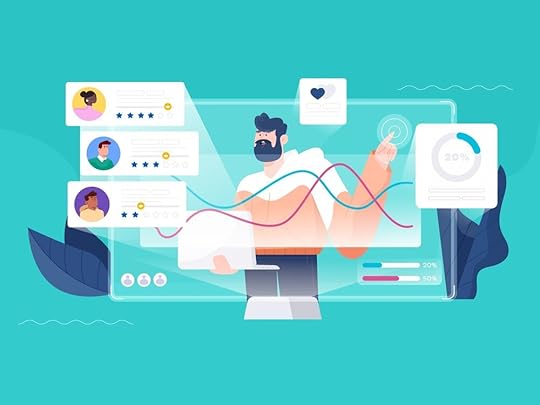
Illustration by Carolina Contreras
How meetings have changed.For the past year the ability to exercise power through meeting power structures such as leveraging gate keepers, seating arrangements and arriving late or slipping away early are for less impactful in a zoom world. Everyone is a single square and showing up late means entering an empty virtual space or more likely the meeting is proceeding without you.
The number of meetings has increased rather than decreased because in a collaborative, fast moving, networked society even with all the social networks and collaborative tools in the world, it is hard to be a manager or a leader without meetings even if it these days it is remote via a screen and you can be dressed in your pajamas.
Another way that meetings have changed in the socially distanced arena is that we often find the meetings more tiring these days. The reason is not because we have trouble staring at other people but because in the office, we rarely looked at each other when we were in a meeting! We did not attend meetings but “stare-a-thons” where we looked not at each other but at three screens. A big screen where some presentation was being projected. Our laptop or iPad where we were attending to emails or reading the news and the mobile screen balanced on our knees below the table where we engaged in social and text messaging. Yes, we were in a room with other people, but we were really staring away from them at some combination of screens.
Instead of circumventing what cannot usually be avoided why not think about how to get the most from the meetings you will be spending your time in?

Illustration by Carolina Contreras
A different way to approach meetings.There are a lot of books and articles on meeting management and how to get the most out of gatherings. Most of them are utter and complete BS because they all focus on how you can get the most out of a meeting, while the focus should be how can you give the most in a meeting.
If you go to a meeting with an “extraction” mindset versus a “giving” mindset you are likely face a number of problems including a) missing meetings where you may have been able to share your knowledge and therefore build goodwill and your brand, b) become so focused on what you are looking for that you do not discover what you need and c) becoming over confident that you know more than anybody else and so you have the ability to forecast before attending a meeting can where you benefit and where you do not.
So, you end up with less and less knowledge, find yourself shocked and surprised at things that come from left field and also suffer a diminished reputation.
To maximize your learning, your reputation and upgrade your meeting experience focus on generosity, empathy and energy as the keys to meetings.
a) Generosity.
How can you leave the person or the people whom you are meeting with or presenting to with a gift? A gift of knowledge or insight or a way to see things that they did not have before. Something that makes them believe that it was a good use of their time to be in the meeting.
Besides knowledge some other ways to be generous include appreciation of their skills and their contributions. Everyone wants to be acknowledged and recognized for their good work.
Another way to be generous is to provide guidance. People are hungry for advice, directions and stories to navigate whatever challenge or situation they face. Providing perspectives, stories and experiences resonate and scale in empowering and growing people.
Knowledge. Appreciation. Guidance.
b) Empathy.
How can you truly understand the other persons perspective and point of view because in doing so you will grow even if you disagree with their perspective or view. If you are presenting, how can you make sure that your talk is relevant to the audience and the issues they have in mind and not some boiler plate boiled anew. Is it not ironic when speakers talk of relevance and customization and customer or content is king but do not customize or make relevant their content to their audience? Basically, they are saying that their time is more valuable than the audience!
Three ways to ensure empathy is to seek to understand by asking, listening and re-stating the problem and situation. By reframing the problem using analogies and other categories and finally by sharing relevant personal experiences.
Understanding signals you are listening. Re-framing telegraphs that the problem or challenge being faced has been shared by others. Personal experiences ensure a human connection and re-enforces that you have been in this person’s shoes or seen others who have been.
c) Energy.
How can you leave the folks in the meeting more energized and feeling better about themselves? So much of success is attitude, belief and hope. So many meetings leave folks dispirited, brow beaten, scared and worried. One does not have to be all bouncing beans unrealistic but let’s be pragmatically enthusiastic if you want progress.
There are three keys to ending a meeting with energy. First is clarity. People should be clear what next steps are for each of them. Second is belief which is a belief that they can tackle these next steps and finally a plan which is how they go about doing the next steps. At the end of every meeting are things clear, do people believe they have the tools and skills to do what is next and do they have a plan?
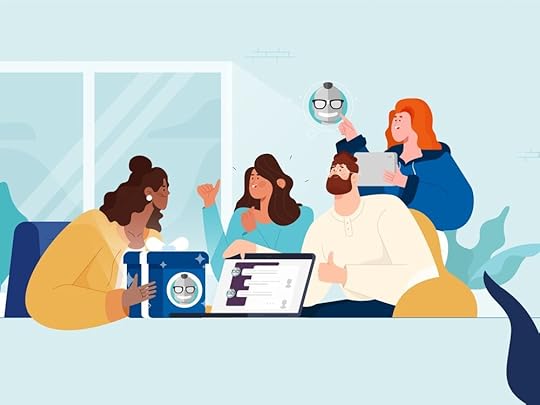
Illustration by Carolina Contreras
The giving mindset to meetings is omni-channel and omni-situation effective!By focusing on giving versus getting you are almost guaranteeing a great meeting because at minimum the other folks leave the room better off, and feeling positive about you. And in feeling that way they become an ally, a supporter and an advocate for you, so you get something out of it.
But actually, what happens is much more. In the course of the meeting once they understand that you are giving without asking, they give in return. Knowledge.Insights. Help. Lots of other stuff. Often in the meeting or as a follow up.
Finally, because you have treated their time as precious, they treat your time as precious.
Don’t think of how to put barriers to meeting people. Don’t think about what you can get. Don’t think through yourself as a filter.
And this approach to meeting works in both the real world and the virtual world. It works across every culture and country. It is effective in both personal and business situations.
Think about the other person or people.
Give yourself and your time first.
And you will find meetings are valuable, fun, educational and energizing.
April 11, 2021
The Transformed Talent Terrain

Photography by Christopher Burkett
Even prior to Covid-19 the talent landscape was undergoing seismic changes driven by technology, demographic shifts and societal changes.
Over the past 15 months Covid-19 has accelerated, accentuated and amplified these changes and added some additional alterations which are likely to lead to the largest shifts in decades on how talent is managed, grown and retained and how talent manage and grow their careers.
There is a divide between white-collar office workers and blue-collar front line/ factory workers and this piece focusses on the changes impacting the former versus the latter and is possibly more relevant in Western countries than those in Asia.

Photography by Christopher Burkett
The five intertwined forces.Five forces ricocheting off and re-enforcing each other are sculpting a new terrain.
1.Demographics: Most countries outside of Africa and the Middle East are aging as people live longer and there is less immigration and fewer children being born. This means more people are going to stay in the workforce longer. In addition, those aged under 34 having grown up in a very different economy (less growth and more shocks), technological (digital natives) and social set up (more liberal and more ethnically diverse) and have very different mindsets and expectations than those over 50 that might be currently leading companies and making up most of Board leadership.
2.Unbundled Workplace: Post vaccine the office is not dead but it will play a lesser role for a variety of reasons from talent preference to work part of the time from home or near their homes ( a third place that is not home or the old HQ office), a need for companies to either manage costs ( lower real estate costs) or be more aggressive in filling open roles and finding scarce expertise (allowing talent to live wherever they want), Covid-19 has made remote work a reality and very few companies will be able to compete for talent without being open to it.
3.Technology: While broadband technology, cloud-based computing and communication software like Zoom and Slack have enabled remote work and collaboration we are on the cusp a quantum jump of enabling technology including integrated AI for improved competency, Voice and Augmented Reality for leaps in communication, and 5G for faster and more resilient connections.
4. Government and Policy: Most governments are tilting resources to labor and collective infrastructure rather than capital and private enterprise, recognizing that after years of disinvestment in society and poor market driven outcomes in some areas such as climate change the pendulum may have swung too far. It is also clear that company leadership is now being asked to take stands and work with, or influence government.
5. Culture: After a long while diverse voice and points of view are now both being heard and paid attention to all over the world as it is clear that for too long too many talented people’s potential was never unleashed or recognized as well as many company cultures needed to be rethought to ensure greater fairness, equality and opportunity.

Photography by Christopher Burkett
The challenges and opportunities facing company management.The new terrain provides some unique opportunities for companies to re-invent themselves to create more fluid, flexible, faster moving and lower cost talent organizations, while also raising challenges in managing cultures, engendering employee loyalty, controlling corporate narrative and dealing with an increasingly complex legal and political talent framework.
1 in 4 workers (26%) plans to look for a job at a different company once the pandemic has subsided, according to Prudential's latest Pulse of the American Worker Survey , conducted by Morning Consult in March. The number of workers planning to bolt their jobs is even higher (34%) for Millennials, the largest generation in the workforce today.
1.Faster moving, more flexible AND lower cost organizations: One of the key differences between a Hertz and an Uber is that Hertz has many fixed costs (they own the cars and have full time employees) while Uber has mostly variable costs (non-employee drivers who bring their own equipment to work). Uber could dial down their costs and then flex their company into food delivery and not just human delivery.
Due to modern technology, the furloughs and cost-reductions of some companies who grappled with a reduction in demand and new supply chains and creative ways to expand talent pools of companies who grappled with meeting a jump in demand, every smart company is re-visiting many “givens”.
Do all employees have to be located near their offices? What is an office and where should they be located and how much space does each company need in which markets? Do all employees have to be full time? How can they re-aggregate different teams and talents around the world in virtual space? How can they combine internal talent with external talent? Is there a new type of worker who is neither full time nor free-lance?
Make no mistake companies who believe they can re-start or go back to where the world is in 2019 are very few if any. There are too many smart people in board rooms and leadership of firms who know this opportunity to re-invent the acquisition, retention, organization and housing of talent will not come again and if they do not adapt to the new realities, they may no longer be around for the next time.
2. Managing cultures and work product: When some talent works remotely most of the time and others work in the office or when some talent is full time and others half time and different countries have different work environments how does one manage a culture?
Does culture require a campus? Is cult like training and indoctrination a part of creating a shared story and fabric of being? Or can stories be told and shared, training proffered, and relationships built without a major need for physical space or gathering outside of a few interludes or for particular phases of a career (early or on boarding).
And if these gatherings are needed do people have to come to the museum like campus of the HQ filled with artifacts of the past or could they all gather for a week at a remote location in a fun place? Automattic has all its employees gathering once a year for a week while teams that work together gather once a quarter for a week at locations of their choice. All the relationship building, training and creative brainstorming is achieved without offices.
Does work product and quality control require physical rubbing of shoulders for white collar workers. Do creative types have to hang out with other creative types for the spark of an idea to be elicited?
What need is there for a manager to physically hover over a person to monitor work product? Has the quality of work declined significantly in distributed workplaces?
Much of the nostalgia for offices is built around serendipity, relationship building and collaboration which is probably true but in no way requires more than a small portion of a work month. (It is likely that the hybrid model will focus on month or quarter as the time period versus the week. Two days a week does not really allow people the flexibility to live far away from their workplace as one week a month or two weeks a quarter do)
Early indications imply that employees prefer working from home at least some or a majority of their time and bosses have got better at being bosses since they now treat employees as people versus as workers since they see them home with their families and pets as well as they have become better communicators since they can no longer expect employees to figure out what is needed through osmosis.
But a company culture is not just physical space and connections with bosses and other employees but also the opportunity to grow and the purpose and values of the company one works for.
Some of the best companies in the world have enhanced their cultures by taking more aggressive roles in standing up for the right things, working closely with government and giving back to society.
Attracting and retaining talent will be as much about policy, purpose and meaning as about fancy campuses or group gatherings and these do not depend on a firm’s organizational structure or the physical footprint of how their talent is housed!
3. The increased role of policy as part of a company’s C-Suite: Recently Tim Cook of Apple noted that while Apple was not interested in getting involved in politics, they needed to take a stand on policies. In many ways next generation talent expects their leadership to take stands.The pressure on the CEOs of Facebook, Google and others are increasingly internal as they seek to attract and retain talent.
If in the old days not taking a policy stand was the smart thing to do since all sides of an issue are potential customers, it is today seen as spineless and cross-purposes to the agenda of most companies to put forth purpose led agendas. If companies stand for a purpose, they will need to take stands on policy increasingly because their talent will demand it.
Clearly this is easier said than done and is fraught with peril but in the cauldron of continuous commotion inflamed by technology, culture, and diversity every leadership team needs to be aware that policy is as much about talent retention and giving muscle to purpose and values as almost anything else in a fast-moving far-flung talent landscape.
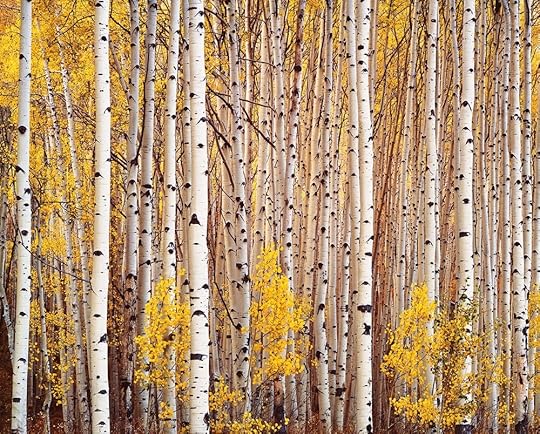
Photography by Christopher Burkett
The risks and potential for talent.The new terrain brings many upsides for talent including a) greater flexibility in working conditions to fit one’s lifestyle, b) increased opportunities given the ability to be hired by any company in the world as one’s physical location becomes less of a constraint and c) new access to learning and experiences as more and more events and people that may have been roped off at a Cannes or Davos or TED or Harvard are available via a Masterclass, a Coursera or a Google Certification. Even as events go back to physical it is very likely a low cost or free online option will continue.
On the other hand, there are some significant risks which include a) the loss of full-time income as companies seek to re-think full time employment, b) increased competition since while the new terrain allows one to perform a job anywhere it allows anyone in the world to perform your job and c) the need to navigate a complex web of different demographic and cultural cues with less ability to build in person relationships or learn from the nuances of the observed but the unsaid.
In order to thrive in this world, one may want to consider this three-pronged plan.
Prong 1. Take charge of your own career and plan it with a long-time horizon: Most people will work for four to five decades because they will be healthy longer, will find meaning in work or may need to work to make ends meet. A company remains in the S&P 500 for less than 15 years and as the world accelerates and shifts it is important to think about your career in different acts and plan for it. This piece entitled 12 Career-Lessons is one person’s perspective you may find useful: https://rishad.substack.com/p/12-career-lessons
Prong 2. Consider using the next six months to do six things that will serve you well including a) stop thinking about a new normal, b) build new screen skills, c) learn to operate as a company of one which means it is critical to build a brand, earn trust and be highly collaborative and d) learn to do with less so it increases your degree of freedom and gives you optionality and leverage. More details on the six-step plan here: https://spark.adobe.com/page/dMocYiB0zlhag/
Prong 3. Cultivate and grow yourself: Your career grows when you grow. And you are more than your work expertise. You will outlive your career. You may outlive many careers. By keeping your career in perspective amidst the greater and broader life you live will help you succeed also at work and as a leader. So, a) learn to deal with love, loss and learning, b) be open. c) mind the gap between who you are and who you want to be, d) unleash the power of compound improvement, e) learn to improvise like jazz and f) read some poetry. More on all these here: https://spark.adobe.com/page/zASIWWv1Z3Wxv/
While the future is uncertain and unknown, if the past is any indicator on the whole things get better. Every person has talent and potential. Every person is both an employee and manager (even if all you manage is yourself). The future does not fit in the containers of the past and neither do you.
You are an immigrant crossing the line into tomorrow’s terrain for talent. And there is no one there but you who can turn you back…
April 4, 2021
Juxtapositions

Artist: Kelly Reemsten
1. Digital silicon-based data driven solutions. Analog carbon-based emotional challengesA machine computes. A human dreams.
The elegance of code is often thwarted by the messiness of people.
Algorithms find co-relations between present and historical data sets. Adventuresome people leave the beaten path and innovate by forging new connections between things that were unconnected before.
Software is written but T.E. Lawrence (Lawrence of Arabia) emphasized “nothing is written” in human progress.
It is imagined.
Silicon Valley believed AI could monitor and clean up the weaponized mess of social media. Lots of computing power and tens of thousands of people later the situation continues to sizzle.
People surprise and are illogical.
Machines are not yet mad.
Math has no meaning.
Meaning often has no math.

Artist: Giorgio de Chirico
2. Diversity of people. The diversity of voices.Diversity is critical.
Diversity ensures innovation as differences of perspectives, voices, and expertise find ways to connect, intersect, compete and intertwine.
The drive to diversity whether it be gender, ethnicity, sexual preference or background is important because it is fair, just and supports ideas, value, freedom and career growth.
Even more critical is that the diverse voices are heard, and diversity is not just diversity of faces or quotas to meet benchmarks.

Artist: Vladimir Kush
3. Why we join. Why we stay.We seek jobs and careers that will afford us money, power and fame.
And we measure our wealth, our span of control and our influence.
But we stay for connections, purpose and personal growth.
Do we feel connected to the people we work with, the purpose and values of the place we spend our lives, and do we feel we are growing as people with our skill and expertise?
We came for the numbers that we could measure on a spreadsheet.
We stayed for the stories that strengthened our heartbeat.
 4. The potential of the old. The fixation on the young.
4. The potential of the old. The fixation on the young.Modern health care indicates that a healthy 52 will not only have money but over 30 years of a physically healthy life. Today the growth market for most businesses in the US and in most developed markets from Europe to Japan are 50+. They do not see themselves as seniors and Covid-19 has underlined that they are open to new behaviors and brands.
But look around at the marketing in most countries which aims decades below where the money is not only in depiction but also tone of voice. Survey the ages of folks in marketing departments and agencies. Millennial fixation did not help Buzzfeed, Vice or Group Nine.
Money and not “viral likes” makes the world go around.

Artist: Pablo Picasso
5. You. The other you.A person in two moods can be more different than any two people.
You are both what you were and what you are as what you will become.
Some things change and some things stay the same.
It is hard enough to understand yourself and really difficult to understand other people.
Thus, let us be careful in both life and in business to believe we have anybody pegged.
When you have someone segmented and boxed and x-rayed. You have measured their ROI and Lifetime value. When you have them tiered and graded and valued remind yourself that someone is doing the same thing to you.
How does it feel?
And don’t you sometimes just do strange things to make their calculations crackle and burn and go all wrong?
You are the marketer and the one marketed to be.
You are the archer, and you are the target.

Artist: John Nieto
6. Balance. Unite. Integrate.In the digital world there are zeros and ones
In the real world there is a spectrum between zero and 1 including zero and ones.
In the fantasy world there is a yes and no for every answer.
In the real world there are yes, no, maybe, depends, later, avoidance of providing an answer.
The wise understand that one has to continuously manage a spectrum.
A spectrum of people, voices, opportunities, options and decisions.
The challenge is how to balance between the outcomes, unite what can be united and integrate the options.
And to remember humans are incomplete, imperfect and impermanent.
As are all the decisions we make and the positions we take.
And in the juxtapositions is where the meaning of life lies.
March 21, 2021
Mindset Architecture

Art by Pablo Picasso
While one may not agree with Hamlets’ statement that “there is nothing good or bad but thinking makes it so”, it is clear that our mindsets matter a lot in how we perceive life, how we are perceived and the degree of success we may have in our varied endeavors.
In rapidly changing and chaotic times an agile mindset can be critical to success. While there are many personal trainers to help sculpt our bodies into somewhat supple forms, there is a scarcity in those who can show us how to exercise our minds to be as flexible as they need to be.
The ability to change one’s mindset and see, feel and think differently about an issue is often the key differentiator between those who succeed and those who do not.
Here are some perspectives on how we can sculpt our minds to thrive in a transforming world:

Art by Pablo Picasso
1. Accept human reality:Life is a journey through reality and time in search of meaning.
We seek meaning within the constraints of reality.
The potential of who we want to be and where we want to go constrained by what is and what will be.
When you live your life are there some underlying beliefs and truths that drive you or you measure yourself against? If we are to grow, where are we trying to go?
Competition it is not with other people but to get better every day and to get closer to what you believe or your ideals. Your success is not housed in other people’s minds (what they think of you) but in their hearts (what they feel about you) and in your mind (what you think of yourself).
At its essence life is about loss, love and learning,
Loss is central to the human experience in three ways. The first is we often lose in our attempts to succeed. We lose pitches, Clients, jobs and opportunities. Many times, we win. Some people win little, and others win a lot. But we all lose. But these losses are not the big ones. The second bigger losses are the losses we will face of loved ones and friends either because relationships end, or death comes, and our final loss is that of our lives.
How we live amidst this loss defines a large part of life.
The joy we make is because time is precious, and this moment of victory may not last forever. Given that loss is part of human existence it pays to be kind and to think about how to help those in loss for do not ask for whom the bell tolls since it tolls for us.
A big part of what makes life worth living despite the guarantee of loss is the hope of love and joy of learning. Love of people, of work, of art, of culture. Love may not compute but computers do not love. There is a great deal of progress made over generations on who one can love, the ability to do things one loves and because of modern technology to be exposed to new worlds, horizons and things to love.
And learning is particularly joyous. Learning in its first form is building knowledge. With great knowledge and practice we build skills and craftsmanship. Learning to see things from other perspectives gives us understanding. Sometimes if we are lucky, we can graduate from knowledge, skills and understanding to wisdom.
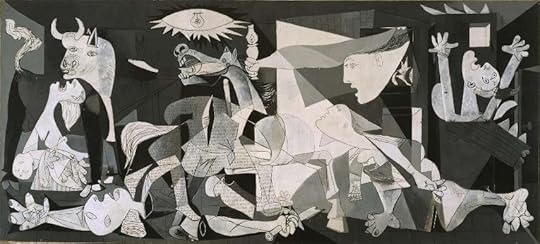
Art by Pablo Picasso
2. Align with the forceYoda wishes that the force be with us. But what is this force that we need to align with? Tangible reality would be a great place to start. Besides human reality that we will all die (but others will be born), there will be loss (but there will also be gains) and life cares about the species and not the individual (sorry but that is how evolution works). Science matters. Gravity does not care whether you accept it. Jump out of a tall building and you will die. Gravity did not care and did not know you existed. In addition to science there are some harsh business realities. Three in particular: Globalization. Digitization. Markets.
One can fantasize as much as one wants but these three forces are unstoppable and now the Internet (“Connection Engine”) acts like Viagra on them, where each force connects to and rejuvenates the other.
If you wish to thrive and make a living accept and prepare yourself for increased digitization, globalization and market forces (markets are why China and India have risen more than anything else over the past two decades). They will be impacting every single industry and crevice of life.
All the fretting, complaining and hoping that these three realities go away is a complete and total waste of time. They just are and they will be. Let us use our energy to learn new digital skills, find ways to expose ourselves to different global experiences and learn a little economics.
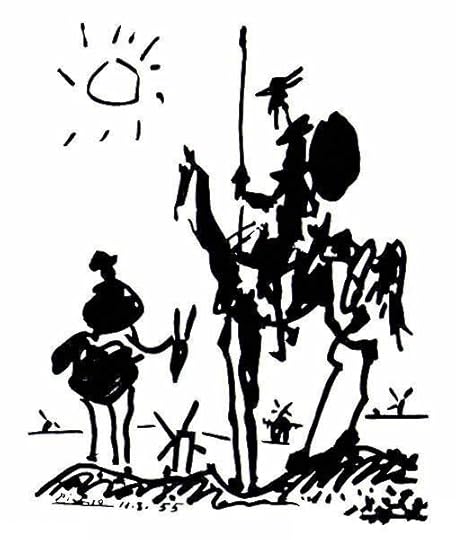
Art by Pablo Picasso
3. Optimism mattersIn the novel “Gravity’s Rainbow” by Thomas Pynchon a character is described as one whose “mood collapsed the room”.
While misery may love company, nobody likes being in the company of miserable people. Optimism is not just an essential component of innovators but a trait that you must have if you wish to inspire folks to follow you. “Woe is me, doomed are us” works for a few drinks in a bar, but at the workplace it saps energy, hurts culture and is just a plain downer. Pessimism is something we all wallow in, but it fails to show the way out. If you cannot get yourself positive about what you do or where you do it for a majority of your working days (there will always be days from hell where you feel crushed and beaten), then do yourself and your company a favor. Quit!
A way to get optimistic is to forget all the legacy nonsense you may have to grapple with and ask that if you had a fresh sheet of paper, a subset of the talent in your firm and its assets (brands, network, money), what would you do? You likely will find you actually are looking forward to what you and your company can do. Every day is a new career beginning. Tomorrow is where you will spend the rest of your life. So, buck up!

Art by Pablo Picasso
4. Recognize the opposite is also trueTo sell a point of view or a recommendation it is critical to know its weaknesses and the information that you may not know. since you are aware of the variables that went into your recommendation.
I suspect folks who only see one side of a story or position. Their minds and positions are not subtle but brittle. Brittle cracks at first true opposition.
Look at the world through a different lens. We can have blind corners in the areas where we are most competent since we often stop needing to look out in those areas. Practice building the strongest opposing case. The stronger you can build it the more likely your recommendation may be correct if you still choose to make it.
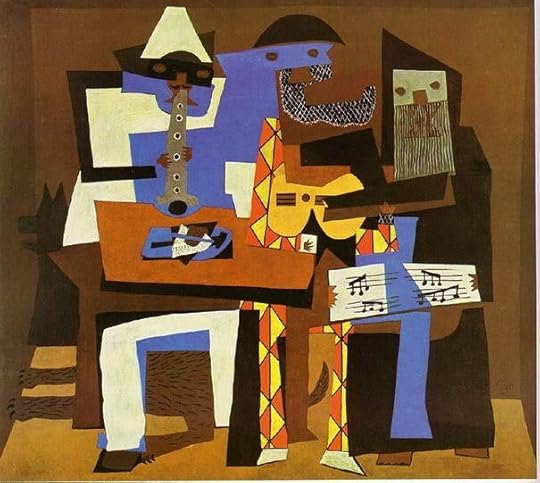
Art by Pablo Picasso
5. Constant iteration & compound improvementInside our hard skulls is the most beautiful software. But like all software if it is not constantly updated and enhanced it will be irrelevant to the applications and tasks that the modern world requires.
We all need to be students again. Apprentices this time since only by doing can we enhance our craft. Iteration happens by doing, testing, incorporating, rejecting, and being active! Do not over think. Every day try to learn one new thing or one new feature or try one new experiment of some sort. Incorporate what works, learn from what does not.
This way your software keeps improving and you signal that you are willing to learn new things and see things in new ways and are not some ossified, stuck in the mud slug of a carbon life form. Computers that cannot run new software are junked regardless of how pioneering, famous and awesome they once were.
Three ways on how you might start this very minute begin to embrace Compounding Improvement
a) Discipline equals freedom: This is the title of a book by Jocko Willink, a Navy Seal. Basically, if you want to get a grip on the world get a grip on yourself.
b) Expose your mind to new and different stimuli: Innovation and change is often about connecting the dots in new ways. To do so, one must be aware and familiar with a lot of dots and not just the dots at work.
The world is changing so fast that many of our skills and expertise and mindsets need continuous upgrading. While many of us set aside time to exercise to maintain our physical operating system we need to also feed and exercise our minds. The power of this habit is that at the end of a year you will have spent 365 hours learning new things by just doing one hour a day. You will gain compound returns to thought!
c) Deliberate practice: Professor Anders Ericcson who died a few month ago wrote a book called “Peak” which is the best study of deliberate practice which entails immediate feedback, clear goals and focus on technique. According to his research, the lack of deliberate practice explained why so many people reach only basic proficiency at something, whether it be a sport, pastime or profession, without ever attaining elite status. A great resource for deliberate practice is here.

Art by Pablo Picasso
6. Improvisation and fluidity.We are living in a jazz age and not a classical one.
In classical music —particularly orchestral music—there is a conductor that musicians follow, sheet music one sticks too and a hushed auditorium one sits in.
Jazz on the other hand is a mix of classical, swing, blues and much more but at its heart it’s about improvisation. It is about playing off each other. There is no conductor. Rare is there a hushed auditorium but more likely a noisy club or the anguish of a lonely saxophone in a subway station.
Today we are living in a diverse, global and connected world where we have to work together, we have to fuse our different cultures and beliefs and constantly adapt and improvise.
We need to shape shift; we need to flow, and we need to adjust.
Water over rock.
Rock against rock leads to small pieces of rock.
Flow.
Water flows above and below and around rock and moves onward.
Soon the rock erodes.
Water over rock.
In the end it is important to understand the difference between internal barriers and external barriers. Most of us complain about external barriers that are often impossible to change but we shirk from attacking our internal barriers which we have much greater control of.
Improve your mindset.
After all, as the famous public service announcement says.” a mind is a terrible thing to waste” …
March 14, 2021
Strategy

Graphic Design by Andrew Footit
What is strategy?Strategy is Future Competitive Advantage.
What will the future look like? What will people need and expect? How will demographics, technology and other global shifts create new competitors or recharge current competitors and how will categories blur, blend and maybe even disappear?
Amidst these new expectations and changing competitive dynamics what advantage will your company offer? A differentiated or better product? A competitive moat of network effects, scale or some other dynamic? A better experience? Speed and value?
While Strategy firms can be amazingly helpful in guiding companies through these questions, most leaders already have a gut instinct on what needs to be done. The deep dive documents, the chanting strategists and the long march of meetings are to bring others along and to provide an intellectual and analytical framework for a decision that clearly had to be made.
If you work for a firm and you have an idea of where the future is going and how changing people’s expectations and emerging technology are going to create challenges or opportunities, you should go to your management and share your thinking.
All you need to talk about is future competitive advantage.

Graphic Design by Andrew Footit
Some key future trends to help build new strategies or interrogate existing strategies.William Shakespeare has great advice to anyone who aims to be a strategist. In his play Julius Caesar, he writes:
We at the height are ready to decline.
There is a tide in the affairs of men
Which, taken at the flood, leads on to fortune;
Omitted, all the voyage of their life
Is bound in shallows and in miseries.
On such a full sea are we now afloat,
And we must take the current when it serves,
Or lose our ventures.
Simply stated pay close attention to shifting trends and tides and make sure you align your venture with where the tide is going.
There are three unstoppable trends that every company and individual must align with wherever they are in the world regardless of the industry in which they compete: 1) Globalization with a new flavor, 2) The Three Demographic Divides and 3) The Third Connected Age of Technology.
1) Globalization with a new flavor.
Globalization will continue to thrive despite the hand wringing of Western institutions and periodicals. However, it will no longer be a unipolar form of Globalization driven by the West, but a multi-polar mix significantly impacted by Asia, primarily China and India, who between them account for a third of global population and possibly half of future growth.
By the end of 2018 only 2 of the busiest container shipping ports in the world were in the West (Rotterdam in the Netherlands at Number 12 and Los Angles at Number 18).
At current fertility rates Africa’s population will increase from 1.2 billion to 2 billion in 2050 and 4 billion in 2100 becoming home to almost half of the world’s population.
Just as Earth is not the center of the Universe, the West while being critically important is unlikely to be the center of globalization that the world revolves around with less than 10% of the population and a third of the global GDP soon declining to less than 25%.
2) The Three Demographic Divides: a)The Divide of Race/Ethnicity, b) The Divide of Urban and Rural and c) The Divide of Generations
These “Divides” in the US were most recently seen during the presidential election. Look carefully and it was not “Red State” or “Blue State” but rather Urban/Rural, Caucasian/Non-Caucasian and Young/Old.
The population of the United States next year under 18 years old will be multi-ethnic and the country whose population growth has slowed to a crawl of less than .35% in 2020 will continue to become a multi-racial mongrel mix of beliefs and dreams that walls and nationalistic rage may seek to make more difficult but cannot truly impede. This blend of talents and cultures will be seen not only a key to innovation but a way to remain a leader as a 1.3 billion plus China continues to accelerate.
The most significant and not as well understood of these divides is the worldview differences between those younger than 30 and those older than 55. These differences are replicated in almost every nation as new generations brought up with mobile and social Internet, a lack of assets and lower expectations plus a dramatic difference in values and goals from climate change to capitalism come to express themselves and enter the workplace and politics. In the US this generation will in the next 10 years inherit 30 trillion or 30% of all US Wealth( most of it going to a fifth of them) and this will add fuel to their burning belief of the need to change.
From financial products (Lemonade, Robin Hood, Square, Bitcoin) to fashion (Virgil Abloh, Kylie Jenner) to media usage (Twitch, TikTok), a new language and infrastructure is being forged which will be turbo-charged like never before due to the disproportionate and long-term impact of Covid-19 on these younger generations. (Not since the Great Depression have so many young adults lived with their parents. In July, 52% of young adults ages 18 to 29 years old resided with one or both of their parents, surpassing the previous peak in 1940, according to a Pew Research Center analysis of Census Bureau data. )
Their voices do not ring today in boardrooms or councils of power (almost all of whom are much older) but make no mistake the drumbeats of their reality will soon throb in the bloodstream of every business and political discussion.
But in the US, it is not just the young but the older to whom not enough attention is being paid.
Every day 10,000 people turn 65 years old and due to modern medicine will live active lives for 15 to 25 years. A segment of them controls most of the wealth in the US while a larger group has no significant assets to retire on. Ageism, Medical Rationing, and many more issues will likely create some intriguing inter-generational dynamics.
These divides occur in every nation. Watch Japan as its population declines by over 25% in the next 30 years unless they allow Immigration or Fertility rates change, or China grappling with the aging population due to the one Child Policy, or countries like India and Egypt challenged to find jobs for their youth.
3) The Third Connected Age
In 1993/1994 we entered the First Connected Age where we were connected to information via what would eventually be Search (Google/Baidu) and connected to transaction via what would grow to become E-Commerce (Amazon/Alibaba).
Around 2007/2008 we entered the Second Connected Age where due to smart phones (Apple/Samsung) we were connected all the time and due to Social Media (Facebook/We Chat) we were connected to everybody.
These first two “Connected Ages” have impacted everything from Elections to a re-ranking of the Fortune 500. It has created great wealth and benefits to people and also brought about the destruction of many livelihoods and the middle-class jobs. It has enabled Uber, Airbnb, Dollar Shave Club. Remember when Facebook paid just 1.5 billion dollars for Instagram with its handful of employees? That was worth more than the Eastman Kodak market cap on that day when Kodak had tens of thousands of Employees. Kodak is now worth half a billion while Instagram is probably the most valuable part of the 800 billion market capitalization of Facebook.
But we have not seen anything yet as we enter the Third Connected Age where we will enjoy four new types of connections as data connects to data and writes software (AI), and all our devices are connected to Supercomputers (Cloud), with much faster connections (5G) and new interfaces to connect (Voice today and AR/VR tomorrow).
Why strategies often fail in implementation
Graphic Design by Andrew Footit
Companies often allocate large swaths of senior management time and budgets for outside specialists to help them sculpt and then move the strategy forward.
A cavalcade of consultants convey and communicate with countless charts creative choices to the C-Suite.
A flurry of futurists frame, focus, and filter the way forward with the finesse of fortune tellers.
Masters of the Universe market M&A moves that might make multiples move upwards and mean many more millions in market-cap.
PR professionals produce and promote points of view that provoke the press to perceive with pristine perspectives.
These efforts when successful result in the first three key steps to strategy implementation
1) A simple and differentiated strategic blueprint.
2) An M&A plan to acquire skills, markets and technology.
3) A re-organization since the future does not fit in the containers of the past.
These are essential ingredients to a recipe of change and growth none of these will work without helping grow and change the people in the organization.
Because while firms are a collection of ideas, technologies, patents, brands, ecosystems and people, it is people who are the key since they create the ideas, technologies, patents, brands and eco-systems!
Michael Tyson said, “Everyone has a plan till they get punched in the face”.
Boards and leadership of firms come quickly to the realization that everything is easy until people get in the way.
Telling people that change is good, threatening them with job loss if they do not change or creating communication materials and slogans to goad them into a cult like devotion to the new dear leader or the way forward rarely works in the short run and will likely fail after the threat of flagellation fades.
Because if there is nothing in it for them, people will out-wit, out-wait, out-pretend, and out-maneuver “management”. Until then they will fill the time genuflecting and bowing and going through the monitored motions of attending the right meetings, muttering the motivational mantras and stating the slogans required.
The keys to implementing strategy.If a strategy is to be leveraged in ways that transform an organization, it is key to remember that the only true transformation happens is when the mindsets and behaviors of the people working for the firm transform.

Graphic Design by Andrew Footit
If you want your organization or team to grow and change you will need to ask your team to initiate a) a three-question exercise while leadership b) delivers three clear answers to employees.
The Three Question Exercise every team should consider doing so they can both understand, get aligned with and contribute to strategy.
1) How do you expect our customers/consumers/members needs and expectations to change in the future?
2) What are our key strengths and weaknesses in meeting and aligning with these shifts?
3) If we had no constraints except, we had to ensure that what we did was legal, that it was technologically possible and financially broke even in 3 years or less what products and services would we design?
This exercise makes people look up from their day to day and understand risks and opportunities and helps them realize the need for doing things differently. As importantly it gets them to contribute and activate the strategy in their areas of competence and expertise.
The Three Clear Answers management needs to deliver to company staff in order for them to align with and implement the strategy:
1) Why are the recommended changes good for their personal career growth?
2) What are the monetary or other incentives to change?
3) When and where will training be provided to help them learn the new skills needed?
Change does not happen because of M&A, press releases, re-organizations or a new leader, all of which undoubtedly play a role.
An organization changes and grows when the people in the organization change and grow.



